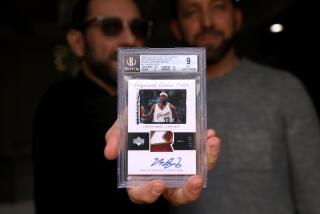Watching someone else open a pack of baseball cards? It’s the latest thrill for collectors
- Share via
Amid the COVID-19 pandemic, the business of opening packs of sports cards online is surging, as customers shut out of hobby shops seek out the thrills of collecting — and the profits.
- Share via
Jason Cordero was shaking. He could barely form a sentence.
“I think I am going to have a heart attack,” he said.
The hockey trading card in his trembling hands was worth upward of $100,000. He’d just pulled it from a pack of cards at Jaspy’s Case Breaks in Hermosa Beach.
But the rookie card of Edmonton Oilers star Connor McDavid wasn’t Cordero’s to keep. He works as an online “breaker,” opening cases, boxes and packs of sports cards for customers who’ve bought them. His efforts are streamed live over the Internet to the company’s patrons, some of whom spend thousands of dollars a month on the hobby.
The customer in question, John McCaull, a retired carpenter from San Diego, had spent about $60 to buy into the December break. In June, he sold the card, which is autographed and contains a piece of McDavid’s uniform, for $135,811 at an online auction. That made it the most expensive modern-day hockey card in existence.
“It’s hard to wrap my brain around it,” said McCaull, 57, who used some of the proceeds to buy a used vehicle he dubbed the “apocalypse van” and is converting it into a camper. “It’s a life-changing event, for sure.”
Sports card collecting is seeing a surge in interest during the coronavirus crisis — and online “breaking” is experiencing notable growth. It’s a pastime made for the internet age: a mix of a classic American hobby and the current trend of YouTube unboxing videos.
Collectors buy into a break — which can cost anywhere from a few to hundreds of dollars — and watch the unwrapping live. Days later, they receive their share of the cards in the mail. In some cases, participants’ positions in a break are randomly assigned; in others, they select a team, and all the cards from that franchise are his or hers to keep.
Either way, it’s all about chance: customers don’t know what cards they’ll receive until the packs are opened. Sometimes a spot in a break yields cards worth only pennies. Other times, a collector hits it big. Streaming videos of the action foster a sense of community for enthusiasts, who cheer each other on in online chat rooms.
A handful of operators, including Jaspy’s Case Breaks co-founder Mike Jaspersen, said that since mid-March, when the coronavirus outbreak led to stay-at-home orders nationwide, their revenue has at least doubled on a year-over-year basis.
“It’s crazy when you think about it,” said Jaspersen, who has worked in the card industry since 1982.
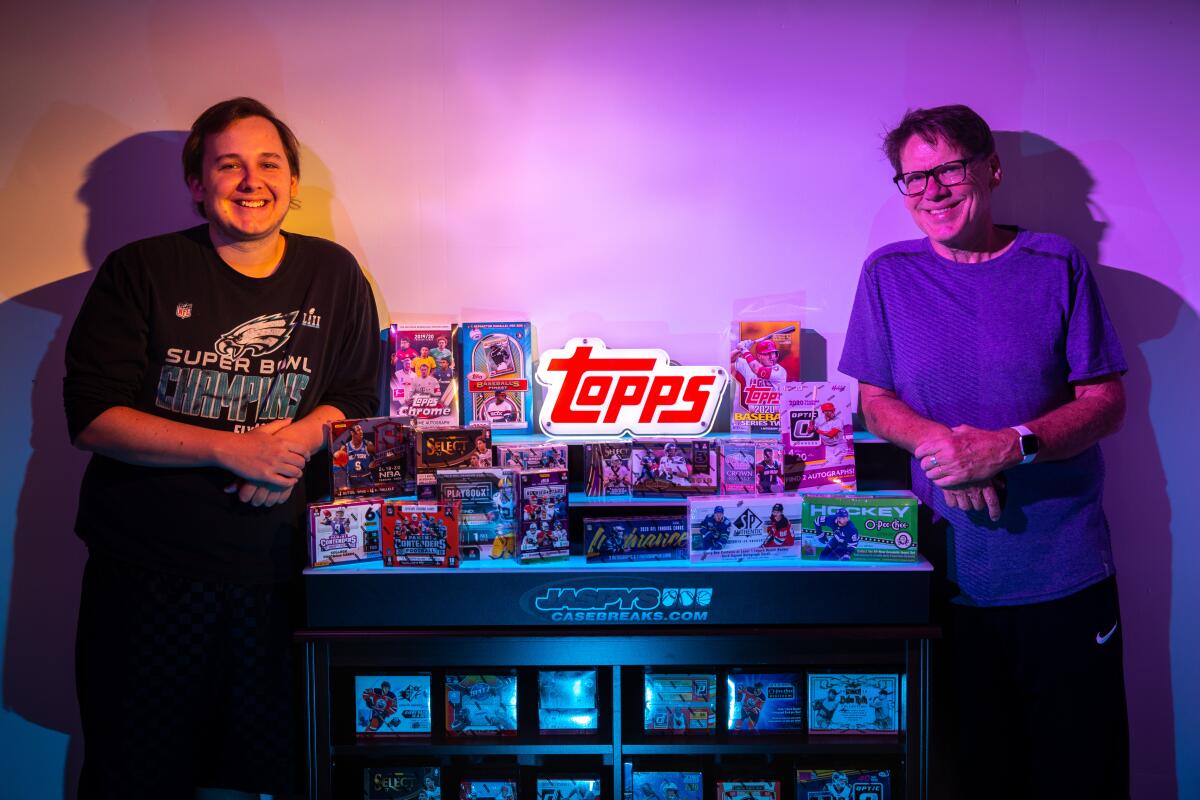
There are several explanations for the growth at a time when unemployment has skyrocketed and nearly every corner of the country has been touched by the COVID-19 pandemic.
The heads of breaking companies said that the lack of live professional sports for several months led many to seek an outlet for their fandom through trading cards. And without sports, there were no games to gamble on, leading some to get their fix via breaks, which are essentially games of chance.
“People weren’t working, they weren’t leaving the house, there was no sports, there was no DraftKings,” Jaspersen said. “It’s entertainment — people stream it on their TV.”
And during the pandemic, when hobby shops are largely closed or operating in a limited fashion, breaking has become a way for some collectors to re-create the experience of opening packs at their local store.
“Some people are reluctant to go into stores now, even if they have a mask on,” said Rich Mueller, editor of Sports Collectors Daily. “One of the things that attracts people is the community, sitting around and talking cards with the owner and whoever else is there. The online part has become a necessity.”
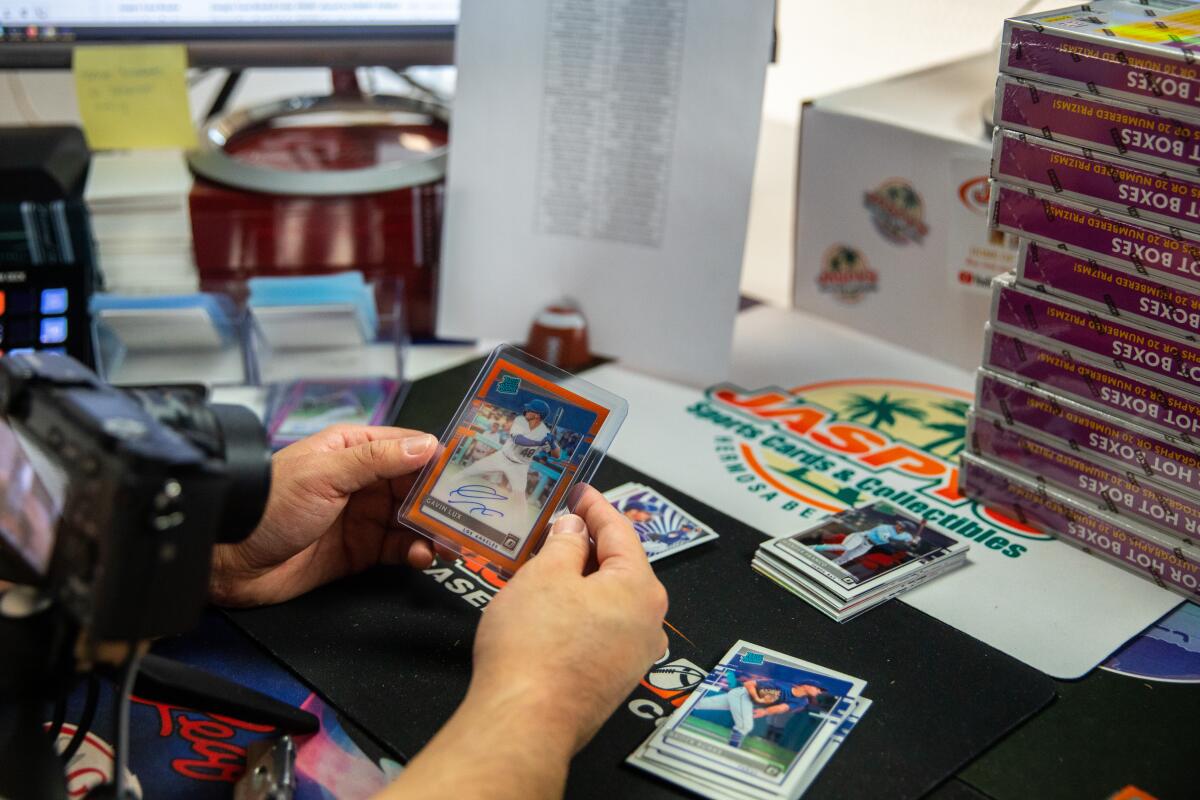
The excitement generated by online breaking can be palpable. Cordero said pulling the McDavid card felt like riding “a big roller coaster at Six Flags.” In the video of the break, Cordero’s exhilaration — equal parts fumbling and joy — is unabashed. He said that sort of action is why he got into the business.
“I pulled it for a customer who was rewarded for giving it a chance,” he said. “That’s one thing with case breaking, it gives people the opportunity. It’s all about luck, really.”
The sports card industry, which once lured customers with little more than the promise of a stale stick of gum, is now a sophisticated field that has benefited from the rise of e-commerce and an ever-increasing obsession with professional athletics. It has seen its share of ups and downs, including a crash in the early 1990s after an explosion in supply caused the market to bottom out.
But over the last decade or so, the business has experienced steady growth, aided in part by the rise of third-party authentication companies, which grade cards on several qualitative attributes, making it easier to establish value and conduct sales.
Alongside grading, the breaking trend has arguably been the biggest change to the business in recent years. And it had been growing at a healthy clip before the pandemic struck. The nascent hobby, which started about a decade ago, gained credibility when the National Sports Collectors Convention — the industry’s biggest event — introduced a case-breaking pavilion in 2014.
“Symbolically, it legitimized it,” Mueller said. “The old-school collectors scoffed, because it is very different. But the National — it is sort of the Super Bowl — and any time they recognize [something] it is a big deal.”
From 2014 to 2019, the number of case-breaking operations at the convention increased by 367% to 70 proprietors, said David Gelfman, who manages the pavilion. He said the convention gave card manufacturers a chance “to see this new class of retailers representing their product in a positive light ... and the customers were able to see who they were sending money to.”
“That’s where case-breaking really exploded,” said Gelfman, who heads a breaking business, Miami-based Ripping Wax.
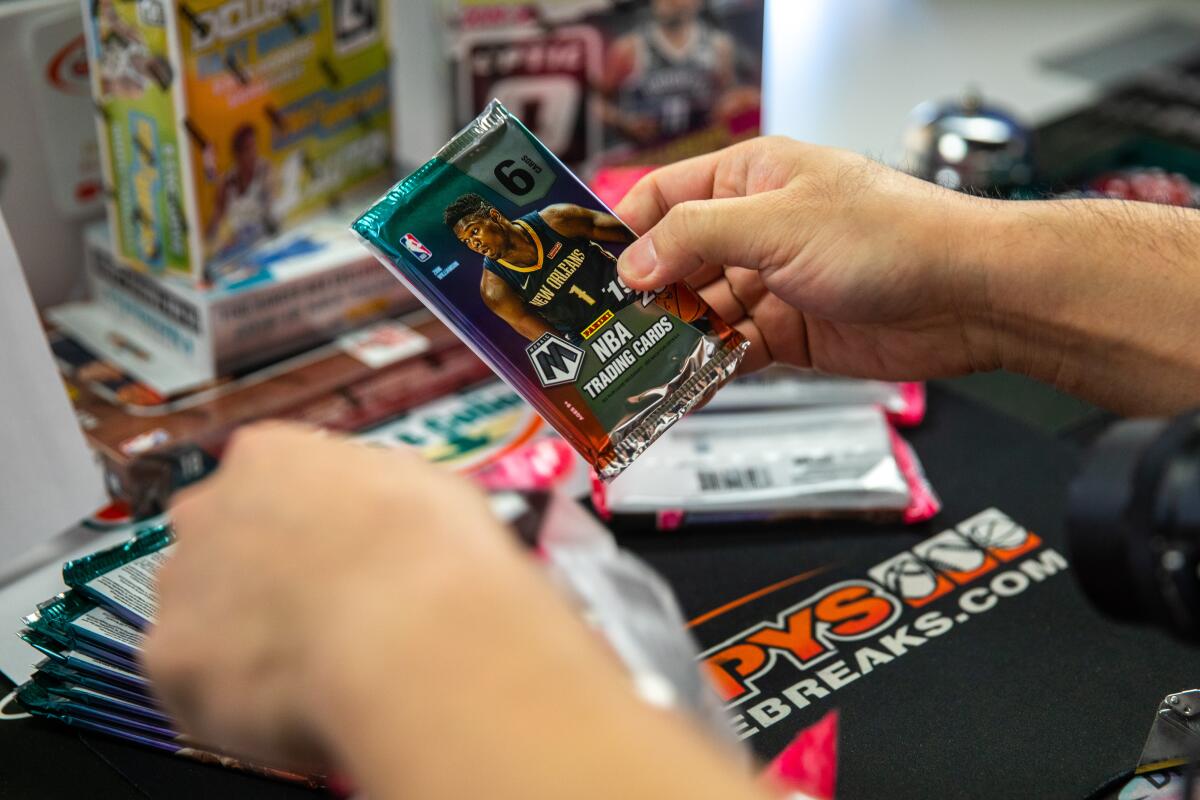
Beyond the camaraderie it fosters, part of the allure of online breaking is that it gives collectors a chance to snag cards from increasingly expensive sets. These days, the business is driven by premium boxes that can cost thousands of dollars and are filled with cards bearing autographs, swatches of game-used uniforms, pieces of playing equipment and more.
“It’s a form of gambling,” Mueller said. “Rather than spend $4,000 on a box ... [participants’] investment is smaller. And while their odds of getting something great are smaller, there is a chance they could get lucky.”
At the top of the market, a 205-card case of the latest Topps Transcendent Collection Baseball costs about $20,000 — out of reach for most collectors. Some of the cards in the set are one-offs, and Nick Jaspersen, who co-founded Jaspy’s with his father, said customers who’ve participated in Transcendent breaks over the years have received autographs of John F. Kennedy, George Washington and other luminaries who never laced up a pair of cleats.
“The companies know a lot of people aren’t going to buy these boxes outright,” said Jaspersen, chief executive of Jaspy’s. “So, the company is saying, ‘Hey, we can make this high-end set we wouldn’t have made 10 years ago.’”
There’s an esoteric element to modern-day collecting, too, where minute differences in cards can drive prices. For example, the McDavid card that McCaull got was especially coveted by collectors because it was No. 97 in a series of 99 — and 97 is the hockey star’s jersey number. That coincidental detail, Cordero said, made it the “holy grail” of hockey cards.
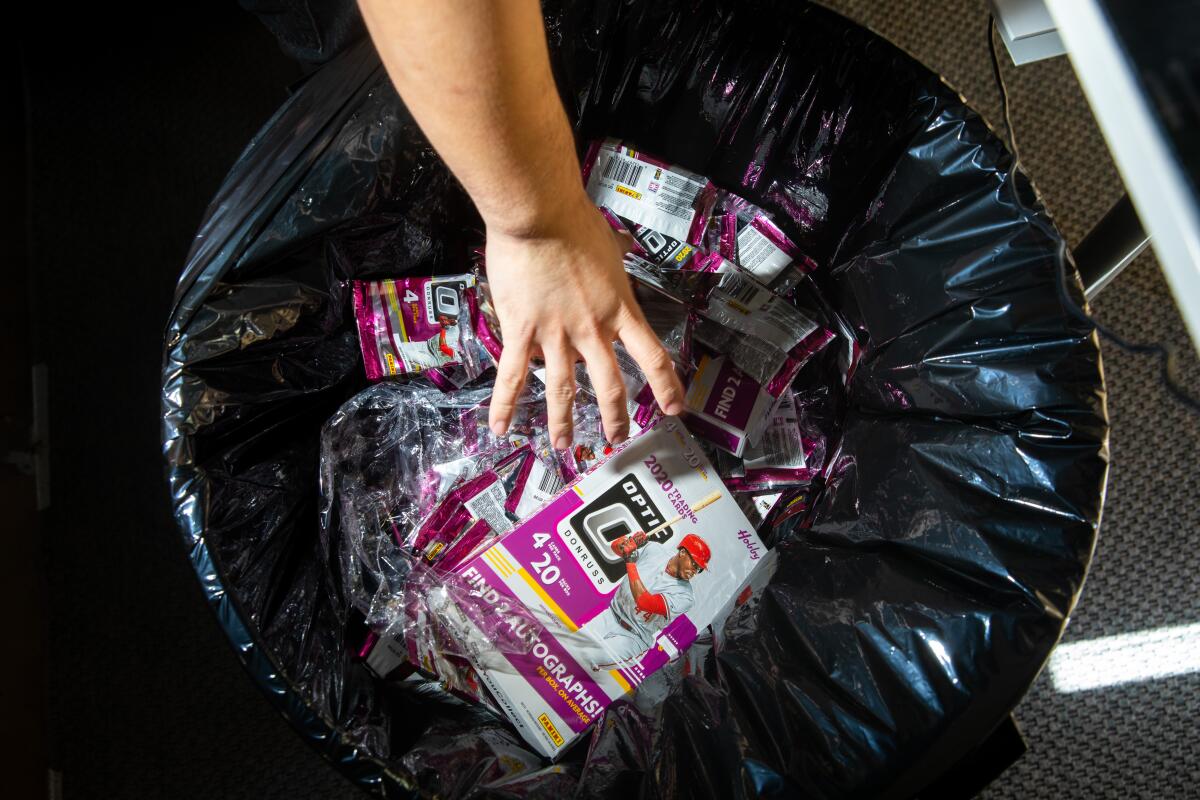
In the breaking business, cards are treated like any other asset — there are several ways to buy, sell and trade them.
Charles Parrino, owner of West Palm Beach, Fla.-based Just Rip It, which specializes in vintage card breaks, debuted his “equity packs” program in 2019, offering a possible money-making opportunity. Customers purchase a share of a pack, and proceeds from the eventual auctioning of cards contained therein are split among the shareholders.
“This equity model gives everybody a chance,” he said.
Still, Parrino, a former stockbroker, acknowledged the risk in viewing these offerings as investments, likening them instead to “entertainment with a chance to pull a great card.”
In late May, Parrino opened a rare 1960 Topps baseball pack (buy-in: $275 per equity share, with 40 total) and pulled the card of New York Yankees legend Mickey Mantle.
“There he is!” Parrino exclaimed on the livestream. “The Mick! If you love Mickey, give me a hell yeah!”
The Mantle card could fetch thousands of dollars at auction. “Tell your wife, ‘This is what we watch that guy for!’” Parrino said on the stream.
At Crackin’ Wax, there’s a charitable component: The company donates 25% of “all cleared profits” after taxes and fees, said Christopher Lawson, owner of the Maple Grove, Minn., company. In May, the firm raised $750 for We Love Lake Street, a Minneapolis nonprofit that works to improve an area business district.
“We wanted to make this a fulfilling hobby,” said Lawson.
Crackin’ Wax’s business has increased dramatically during the pandemic — a fortuitous turn, Lawson said, because in March he was furloughed from his full-time position at a hotel due to the pandemic. Bolstered by Crackin’ Wax’s success, he decided to leave his hospitality job in July to devote himself to online breaking.
“If you were to have asked me when lockdown started how the hobby would respond, I would’ve told you trading cards are nonessential — people are not working and people aren’t going to want to spend. It has turned out to be quite the opposite.”
Jaspy’s has certainly found that to be the case, too. In May, the company had its best month of sales ever, generating $1.114 million in revenue for its breaking business, up 259% from $310,000 for the same month a year earlier.
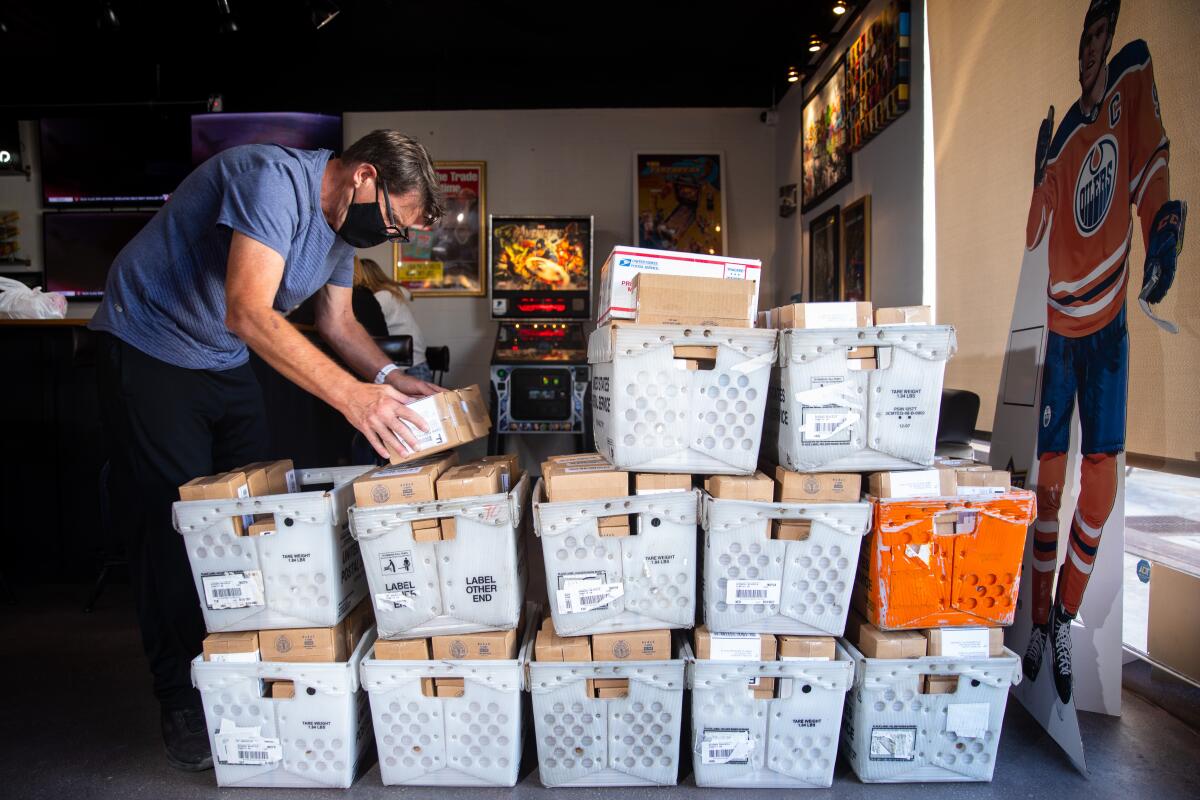
Jaspy’s has 13 employees and runs online breaks seven days a week from its store, which opened in December. It is Mike Jaspersen’s fourth sports card shop; he also had a 14-year tenure as an executive at Topps Co., the trading card giant. The recent opening of the Pacific Coast Highway shop was a major milestone for Jaspy’s, which was started in 2014 out of the Jaspersens’ garage.
But the facility has been closed to customers during the pandemic, and its gleaming display cases are largely empty. What aren’t empty, though, are two studios: one for breaks done for individual customers via Instagram and the other for group breaks streamed on the Internet.
There’s a bit of a learning curve to participating in a break — there’s lingo and rules to master, said Joe Lee, the company’s lead breaker. For example, in breaks that allow customers to select a team, popular ones such as the Dodgers can be four times the cost of middling franchises. Shoppers on a budget who collect Blue Crew cards might therefore take their chances on a less expensive break in which the teams are randomized, and hope for their favorite club.
“There are a lot of layers involved,” Lee said.
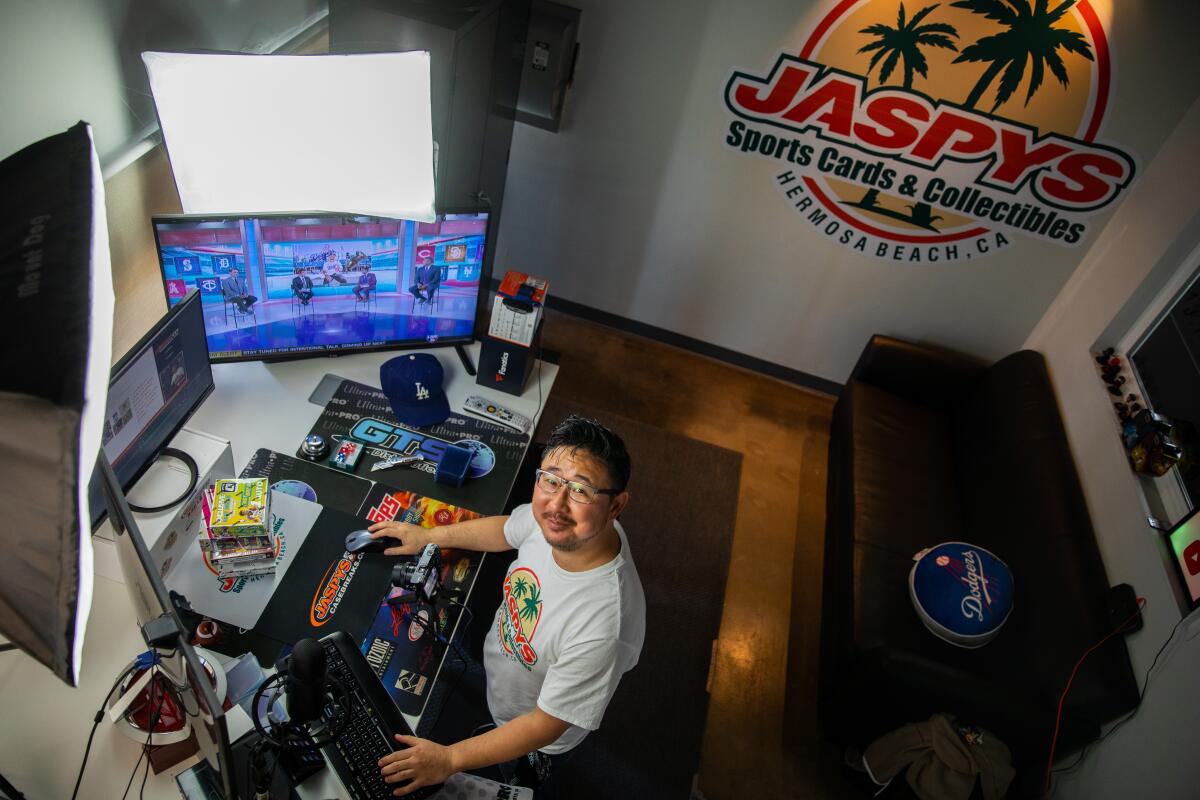
Lee works from 1 to 9 p.m. out of the group break studio. Situated at a standing desk and surrounded by three monitors and two soft box lights, he moves quickly, tearing into packs with precision. An array of cameras — one trained on his hands, another on his desk and a third focused on his face — give the audience a complete view.
On Major League Baseball’s opening day, Lee offered a steady stream of commentary as he opened packs — peppering in thoughts on the impending game between the Washington Nationals and the Yankees, and the ceremonial first pitch, thrown by Dr. Anthony Fauci. (“Let’s see what kind of arm Fauci has.... Oh, just a bit outside.”)
For his part, the elder Jaspersen believes that online breaking reinforces the best parts of the sports card industry.
“It’s family-friendly, it makes people feel good, and it solidifies their interest,” he said. “It builds that online community, and it’s even stronger during COVID.”
McCaull, the winner of the McDavid card, has continued to participate during the pandemic. “I got into some breaks just last night,” he said.
And how’d he do?
“You know,” he said, “it’s hit and miss.”
More to Read
Inside the business of entertainment
The Wide Shot brings you news, analysis and insights on everything from streaming wars to production — and what it all means for the future.
You may occasionally receive promotional content from the Los Angeles Times.



